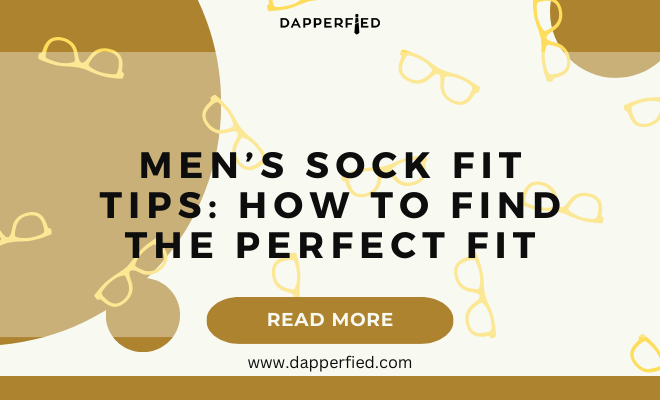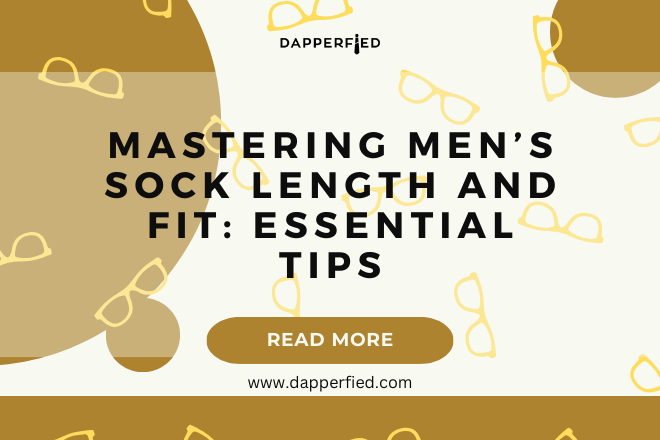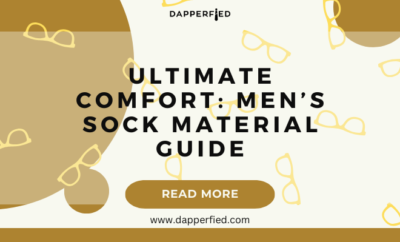
Men's Style
Men’s Sock Fit Tips: How to Find the Perfect Fit
The importance of proper sock fit cannot be overstated for maintaining foot health and comfort. Ill-fitting socks can cause various problems, including blisters, calluses, and foot pain. Overly tight socks may impede blood circulation and cause discomfort, while loose socks can result in friction and irritation.
Incorrectly sized socks can also affect shoe fit, potentially leading to foot issues. Therefore, selecting socks with the appropriate fit is crucial for ensuring optimal foot support and comfort. Proper sock fit also plays a significant role in moisture management.
Excessively tight socks can promote sweating and moisture accumulation, increasing the risk of fungal infections like athlete’s foot. Conversely, loose socks may not effectively absorb and wick away moisture, leaving feet damp and uncomfortable. Choosing the correct sock size and fit helps prevent these issues, keeping feet dry and comfortable throughout daily activities.
Key Takeaways
- Proper sock fit is important for comfort, performance, and foot health
- Understanding sock sizes and materials is crucial for finding the right fit
- Tips for finding the right sock length include considering the type of shoes and activity
- Choosing the right sock thickness depends on the weather and activity level
- Different activities require different sock fits for optimal performance and comfort
- Common mistakes to avoid when choosing socks include ignoring sock size and material
- To maintain the perfect sock fit, wash socks inside out and air dry to prevent shrinking
Understanding Sock Sizes and Materials
Understanding Sock Sizes
Sock sizes can vary depending on the brand and style, so it’s essential to pay attention to sizing charts and recommendations to ensure a proper fit. Socks are typically available in sizes ranging from small to extra-large, with some brands offering specific sizing for men and women. Additionally, some socks are designed with specific foot shapes in mind, such as narrow or wide widths, so it’s important to consider these factors when choosing the right size for your feet.
The Importance of Material
In addition to size, the material of the sock also plays a significant role in determining the fit and comfort level. Common sock materials include cotton, wool, synthetic blends, and moisture-wicking fabrics. Each material has its own unique properties, such as breathability, moisture-wicking capabilities, and insulation.
Choosing the Right Material for Your Needs
Understanding these properties can help you choose the right material for your specific needs, whether you’re looking for socks to keep your feet warm in cold weather or to keep them dry during physical activity. By considering both size and material, you can find the perfect socks that provide optimal comfort and performance.
Tips for Finding the Right Sock Length
Finding the right sock length is essential for both comfort and functionality. Socks come in various lengths, including no-show, ankle, crew, and knee-high styles. The right length for you will depend on your personal preferences as well as the activities you’ll be engaging in while wearing the socks.
For example, no-show socks are great for wearing with sneakers or loafers, while crew or knee-high socks provide additional warmth and protection during outdoor activities or in colder weather. When choosing the right sock length, it’s important to consider the fit with your shoes as well. For example, if you’re wearing boots or high-top sneakers, you may want to opt for a longer sock to prevent rubbing and discomfort around the ankles.
On the other hand, if you’re wearing low-cut shoes or sandals, a shorter sock length may be more appropriate. Ultimately, finding the right sock length is about finding a balance between comfort, functionality, and personal style.
How to Choose the Right Sock Thickness
| Sock Thickness | Material | Season | Activity |
|---|---|---|---|
| Thin | Cotton, Nylon | Summer | Running, Cycling |
| Medium | Merino Wool, Polyester | Spring, Fall | Hiking, Walking |
| Thick | Merino Wool, Acrylic | Winter | Skiing, Snowboarding |
Choosing the right sock thickness is crucial for providing the right level of cushioning and support for your feet. Socks come in various thicknesses, ranging from ultra-thin to extra-thick, and each thickness serves a different purpose. Thin socks are great for providing a lightweight and breathable option for warm weather or athletic activities, while thicker socks offer additional cushioning and insulation for colder weather or high-impact activities.
When choosing the right sock thickness, it’s important to consider the fit with your shoes as well. Thicker socks may require a larger shoe size to accommodate the additional bulk, while thinner socks may allow for a more snug fit. Additionally, the thickness of the sock can also affect its moisture-wicking capabilities, so it’s important to choose a thickness that aligns with your activity level and climate.
By paying attention to these factors, you can ensure that you choose the right sock thickness for your specific needs.
Finding the Perfect Sock Fit for Different Activities
Finding the perfect sock fit for different activities is essential for ensuring comfort and performance. For athletic activities such as running or hiking, it’s important to choose socks that provide cushioning and support in key areas such as the heel and arch. Look for socks with reinforced cushioning in these areas to help prevent blisters and provide additional support during high-impact movements.

For everyday wear or work activities, choosing socks with moisture-wicking properties can help keep your feet dry and comfortable throughout the day. Additionally, consider the length of the sock based on the type of shoes you’ll be wearing and the level of coverage you prefer. No-show socks are great for casual wear or warmer weather, while crew or knee-high socks provide additional warmth and protection in colder climates or during outdoor activities.
Common Mistakes to Avoid When Choosing Socks
Getting the Right Fit
One of the most common mistakes is wearing socks that are too small or too large for their feet. Ill-fitting socks can lead to discomfort, blisters, and foot pain, so it’s important to pay attention to sizing charts and recommendations when choosing socks.
Choosing the Right Material
Another common mistake is overlooking the importance of sock materials. Different materials offer different properties such as breathability, moisture-wicking capabilities, and insulation. By choosing the right material for your specific needs, you can ensure that your socks provide the right level of comfort and support for your feet.
Maintaining Your Socks
Additionally, many people overlook the importance of replacing old or worn-out socks. Over time, socks can lose their elasticity and cushioning, leading to a poor fit and reduced comfort. It’s important to regularly inspect your socks for signs of wear and tear and replace them as needed to maintain proper foot health and comfort.
Tips for Maintaining the Perfect Sock Fit
Maintaining the perfect sock fit is essential for ensuring long-lasting comfort and support for your feet. One of the best ways to maintain the perfect sock fit is to follow care instructions provided by the manufacturer. This may include washing your socks in cold water and avoiding high heat when drying them to prevent shrinkage and stretching.
Additionally, it’s important to regularly inspect your socks for signs of wear and tear such as thinning fabric or stretched-out elastic. By replacing old or worn-out socks with new ones, you can ensure that you always have a proper fit that provides the right level of support and comfort for your feet. Finally, investing in high-quality socks made from durable materials can help maintain the perfect sock fit over time.
Look for socks with reinforced cushioning in key areas such as the heel and arch to prevent premature wear and maintain their shape and support through repeated use. By following these tips, you can ensure that you maintain the perfect sock fit for long-lasting comfort and foot health.
If you’re looking for the perfect pair of shoes to complement your sock game, check out this review of the Cole Haan Men’s Lenox Hill Casual Wingtip on Dapperfied. These stylish and versatile shoes are a great option for any man looking to step up their footwear game. Whether you’re dressing up for a special occasion or just want to add a touch of sophistication to your everyday look, these wingtips are a great choice. And while you’re at it, why not pair them with a sleek and stylish watch like the Raymond Weil Men’s 54661-STC-00300 Quartz Stainless Steel White Dial Watch? For more tips on elevating your style, check out Dapperfied’s article on men’s gold watches for the modern gent. (source)

FAQs
What are some tips for finding the right sock fit for men?
Some tips for finding the right sock fit for men include choosing the correct sock size, considering the length of the sock, and paying attention to the material and construction of the sock.
How do I choose the correct sock size?
To choose the correct sock size, it is important to refer to the sizing chart provided by the sock manufacturer. Sock sizes are typically based on shoe size, so it is important to know your shoe size when selecting socks.
What should I consider when it comes to the length of the sock?
When considering the length of the sock, it is important to think about the type of shoes you will be wearing with the socks. For example, if you are wearing dress shoes, you may want to choose a dress sock that is a bit shorter and sits below the calf. For casual or athletic shoes, you may prefer a crew or mid-calf length sock.
Why is the material and construction of the sock important?
The material and construction of the sock can greatly impact the fit and comfort. It is important to choose socks made from breathable and moisture-wicking materials, such as cotton or wool blends. Additionally, paying attention to features such as cushioning, arch support, and seamless toes can also contribute to a better fit.
How can I ensure a proper fit when trying on socks?
When trying on socks, it is important to pay attention to any bunching or sagging, as this can indicate that the socks are too large. Conversely, if the socks feel too tight or constricting, it may be a sign that they are too small. It is important to find a balance where the socks are snug and stay in place without being too tight.















